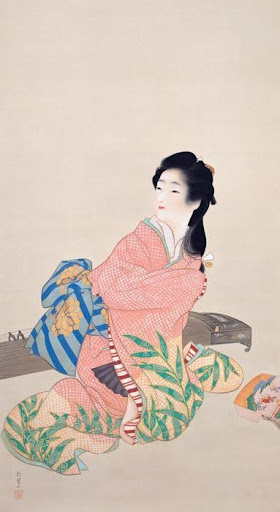20.娘深雪
(Daughter Miyuki)
女性の内面の情念や気品を描くことを追求した作品

《娘深雪》 1914年に描かれた上村松園の代表作のひとつ。人形浄瑠璃や歌舞伎で知られる『生写朝顔話(しょううつしあさがおばなし)』のヒロイン・深雪を題材にした作品。物語の中で、深雪は恋人と離れ離れになり、悲しみのあまり盲目となるという運命に翻弄されながらも、ひたむきに愛を貫く、初々しい恋心と、それに伴う羞恥やときめきが繊細に描かれている。振袖は、曙色に染めた総鹿の子模様で、柔らかさと可憐さを演出。袂と裾には葦が描かれ、物語の舞台である宇治川のほとりを暗示。帯は「吉彌結び」と呼ばれる上方歌舞伎俳優・上村吉彌が始めた結び方で、物語性と恋に揺れる少女の一瞬の表情と仕草を通して、しなやかで折れない強さを感じさせる女性像を演出している。松園の代表作として高く評価されている。物語性、衣装の考証、心理描写のすべてが融合した美人画の傑作である。
Daughter Miyuki (1914)
A pursuit of inner emotion and grace
Painted in 1914, Daughter Miyuki is one of Shōen Uemura’s most celebrated works. The subject is Miyuki, the heroine of Sho Utsushi Asagao-banashi, known from puppet theater (ningyō jōruri) and kabuki. In the story, Miyuki is separated from her lover and, overwhelmed by sorrow, loses her sight—yet remains steadfast in her devotion.
Uemura delicately captures the innocence of love, along with the accompanying feelings of embarrassment and longing. Miyuki’s furisode is dyed in a soft dawn hue and adorned with a kanoko pattern, evoking tenderness and charm. Reed motifs on her sleeves and hem subtly reference the banks of the Uji River, the story’s setting.
Her obi is tied in the Kichiya musubi style, named after the Kamigata kabuki actor Kamimura Kichiya. Through a fleeting gesture and expression, the painting conveys a supple yet unyielding strength in the young woman’s character. With its fusion of narrative depth, historical costume accuracy, and psychological nuance, this bijin-ga stands as a masterwork.
お問い合わせ
〒154-0024 東京都世田谷区三軒茶屋1-39-7